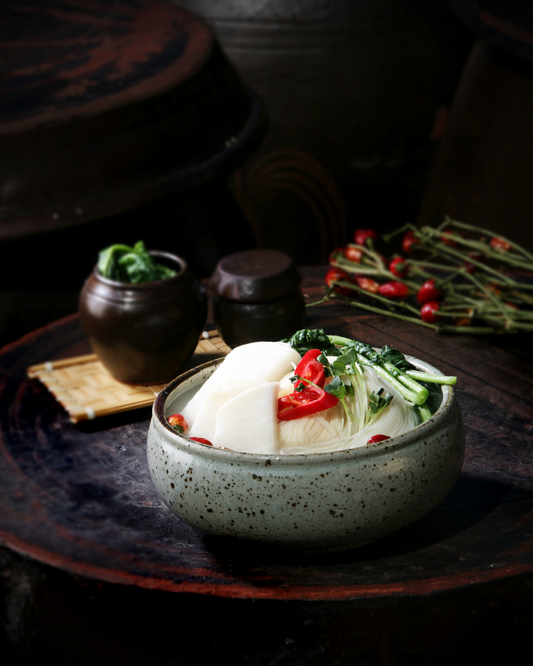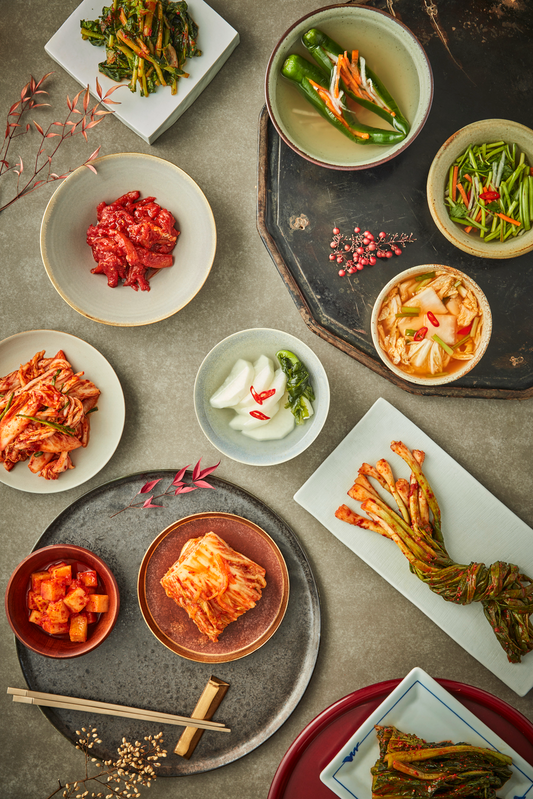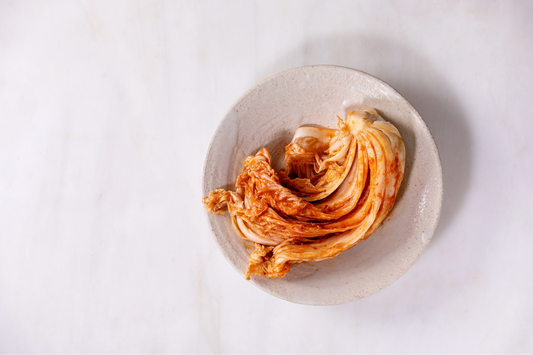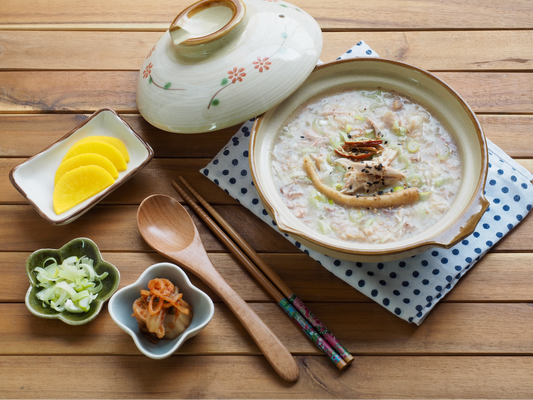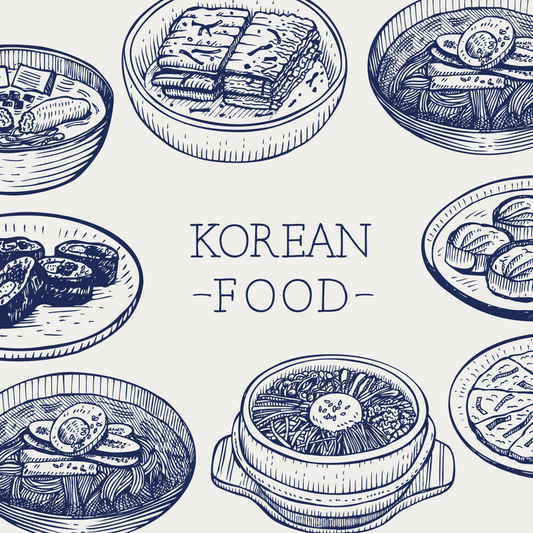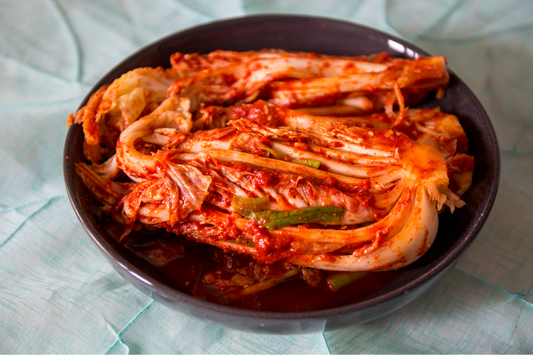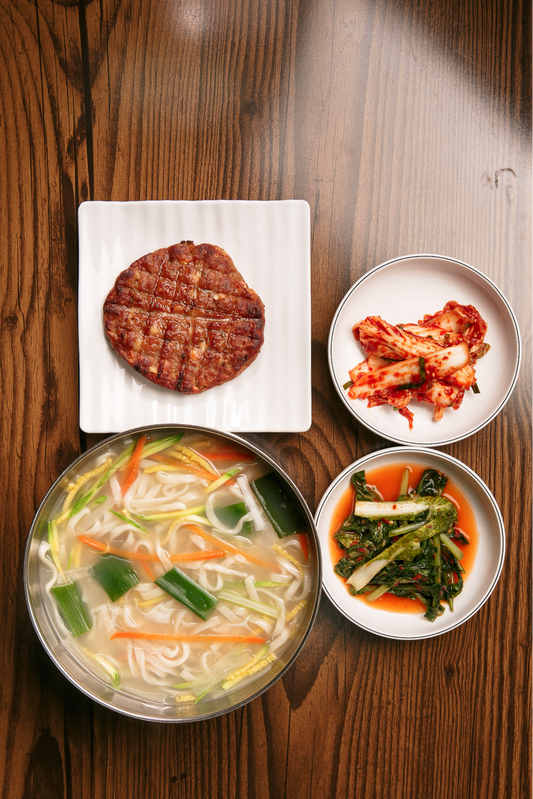Seasonal Kimchi Recipes: Enjoy Spring Greens, Cucumber, Napa Cabbage, and Dongchimi for Each Season
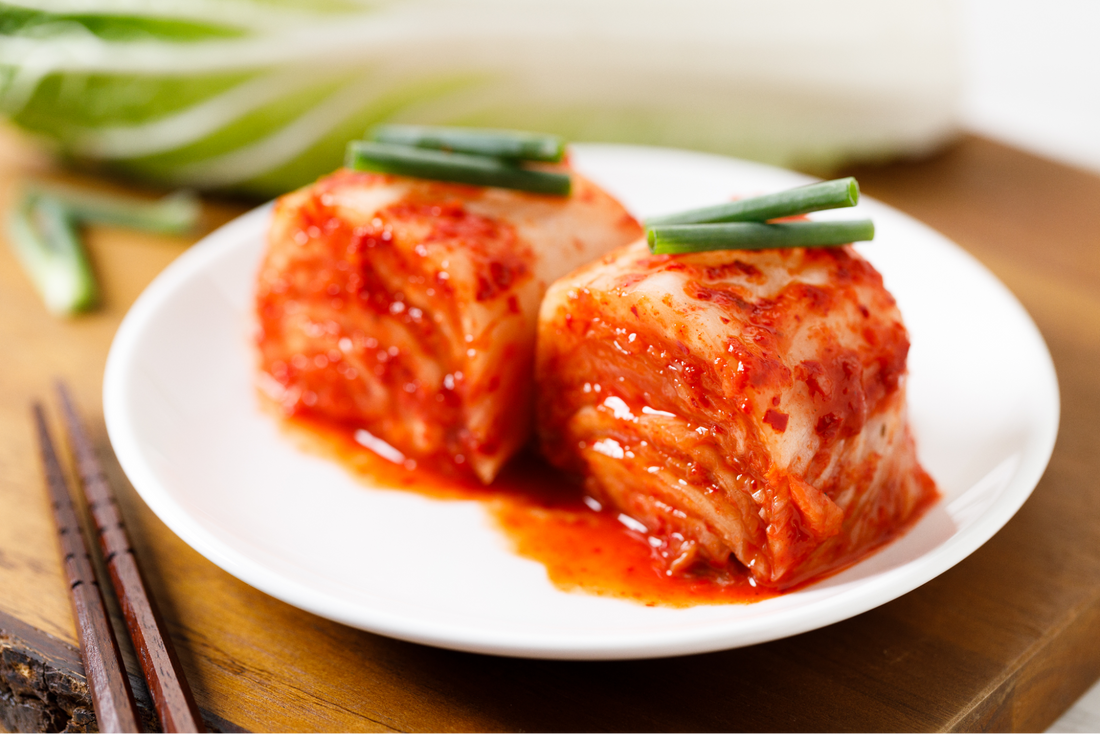
Have you ever thought about the complex flavors and traditions in homemade kimchi? From the fresh taste of spring greens to the rich warmth of Napa cabbage, kimchi varies with the seasons. It's more than just a fermented food. Kimchi is a trip through Korea's culinary history. It uses seasonal produce to make unique, healthy fermented foods all year. This article will explore how the changing seasons influence the making of different, tasty, and healthy kimchi types.
Key Takeaways
- Understand the role seasonal availability plays in shaping the variety and flavors of traditional Korean kimchi.
- Explore the vast array of kimchi recipes, showcasing ingredients like Napa cabbage and Korean radishes.
- Discover vegetarian options in kimchi preparation, highlighting healthy fermented foods for all diets.
- Learn the essentials of homemade kimchi, from choosing the right Napa cabbage to perfecting fermentation techniques.
- Gain insight into the cultural significance of this year-round kimchi, ingrained in Korean cuisine and way of life.
- Reveal the surprising impact of seasonal variations on the nutritional benefits and flavors of kimchi recipes.

Kimchi by Season
The making of seasonal kimchi is a core part of Korean culture. It changes with the seasons to match different ingredients and health needs. In spring, there's a focus on light and refreshing kimchi, like the bright nabak kimchi. Nabak kimchi is mostly fresh and celebrates spring's vegetables.
Summer brings cooling kimchi like oi sobagi to the table. These are less spicy and use refreshing ingredients such as cucumbers. They match the hot weather perfectly.
Autumn is known for the rich flavors of gimjang, the kimchi-making season. Families like Seoyoung's prepare a lot of kimchi, about 70 heads of cabbage each. They make sure there's enough kimchi for the winter. They focus on preparing brined cabbage with red chili powder, garlic, and pumpkin broth. This brings out the kimchi benefits of nutrients and probiotics.
When winter arrives, people prefer kimchis like dongchimi. This watery kimchi, made with radish, offers a clear, soothing broth. It's a must-have in the cold months. The detailed kimchi-making process shows the value of kimchi in Korean diets. It's more than food; it's a cultural heritage that's celebrated everywhere.
The tradition of making seasonal kimchi supports health all year. Each season brings its own flavorful and nutritious kimchi. From spring's fresh greens to winter's rich ferments, kimchi is a key part of Korean cuisine.
Kimchi for Spring
As winter leaves, spring brings new foods and longer days. Among these, spring kimchi stands out in Korean cuisine. It features spring greens geotjeori and chonggak kimchi. These versions are fresh and highlight new vegetables' flavors.
Spring Greens Geotjeori: Characteristics of Fresh Kimchi Made with Spring Cabbage
Spring greens geotjeori is a special kimchi. It's fresh, not fermented, with a crisp taste. It uses young spring cabbage and seasonal greens mixed with chili, garlic, and a touch of fish sauce. This kimchi lets spring vegetables' natural sweetness and softness stand out. It's a great addition to heavy meals.
Chonggak Kimchi (Young Radish Kimchi): The Taste and Benefits of Kimchi Made with Fresh Radish in Spring
Chonggak kimchi stars the young radish or chonggak. Harvested in spring, these radishes are crisp and full of flavor. This young radish kimchi is slightly spicy and tangy, showing off spring's energy. It also has many health benefits of kimchi, like better digestion and stronger immunity, thanks to fermentation and helpful probiotics.
Benefits of Spring Kimchi: The Refreshing Taste and Health Benefits Provided by Spring Kimchi
Spring kimchi is more than tasty. It's full of vitamins and minerals, improving gut health and overall wellness. The young vegetables used increase the benefits of spring vegetables. This makes spring kimchi both delicious and nutritious. Eating it during this season brings enzymes and probiotics that help shake off winter and welcome spring.
Enjoyed as a side or a main dish, these refreshing kimchi recipes blend new vegetable flavors with Korean cooking traditions. They truly celebrate spring.

Kimchi for Summer
In the hot summer, it's important to eat food that is both refreshing and nutritious. Oi kimchi (cucumber kimchi) and yeolmu kimchi (young radish water kimchi) are perfect. They're not only cooling but also good for your stomach.
Oi Kimchi (Cucumber Kimchi): Cool and Refreshing Cucumber Kimchi for Summer and Its Recipe
Oi kimchi is a favorite in summer. It's made from cucumbers, which are plentiful in these months. The recipe takes about 1 hour and 18 minutes for 15 servings. It keeps cucumbers' natural taste with just enough seasoning.
This type of kimchi has a cooling effect thanks to ingredients like fresh red chilies and garlic. Rice flour paste and ginger add great flavors too. It's an ideal dish for staying cool.
Yeolmu Kimchi (Young Radish Kimchi): Characteristics and Recipe of Yeolmu Kimchi to Beat the Summer Heat
Yeolmu kimchi is great for hot days. It uses young radishes in a less spicy, clear broth. This keeps things cool and soothing. The radishes are sliced thin and seasoned lightly, then left to ferment.
This makes the radish stay crisp and allows the taste to develop beautifully. Yeolmu kimchi is a refreshing addition to any summer dinner.
Benefits of Summer Kimchi: The Cooling and Light Benefits of Kimchi Suitable for Summer
Summer kimchi like oi kimchi and yeolmu kimchi offer more than just a cooling taste. These kimchis are full of nutrients, thanks to fermentation. They are especially good for your digestive system.
They're made with ingredients that hydrate you and replenish lost electrolytes. Their light seasoning makes sure they don't overpower summer meals. These ingredients make summer meals both delicious and healthy.

Kimchi for Autumn
Autumn is a key time for Korean cooking, especially for making nutritious kimchi. Baechu kimchi and seokbakji, or mixed radish kimchi, stand out. They use fresh napa cabbage and radishes, key kimchi ingredients. The cool autumn weather is perfect for fermenting veggies. It makes the kimchi taste richer and more vibrant.
Baechu Kimchi (Napa Cabbage Kimchi): Characteristics and Flavor of Kimchi Made with Napa Cabbage in Autumn
Baechu kimchi is loved for its crunchy napa cabbage, picked at its best. This kimchi becomes more flavorful as it ferments. It keeps its crunch yet gains a deep, spicy, and savory taste. Garlic, ginger, and red pepper add to its unforgettable and healthful character.
Seokbakji (Mixed Radish and Cabbage Kimchi): Benefits of Kimchi Made with Napa Cabbage and Radish, Perfect for Autumn
Seokbakji mixes radishes with napa cabbage in a unique autumn kimchi. It perfectly balances the strong taste of radishes with cabbage's sweetness. Autumn kimchi like seokbakji boosts gut health and the immune system. This is thanks to the probiotics formed during fermentation.
Benefits of Autumn Kimchi: The Rich Flavor and Health Benefits of Kimchi During Seasonal Change
Autumn kimchi offers more than great taste. The use of specific veggies and the autumn climate help ferment it longer. This increases the probiotics, fighting gut problems and boosting overall health. Autumn kimchi is a nutritious and probiotic-rich food, important for health in the colder months.
Kimchi for Winter
When winter comes, we all look for foods that make us feel warm and cozy inside. Kimchi is one of those foods, deeply rooted in Korean tradition. It even got recognized by UNESCO as an Intangible Cultural Heritage! Winter brings special kinds of kimchi like dongchimi and baek kimchi. These offer a lighter taste during the cold months. They balance out the richer, heavier meals we often eat in winter.
Dongchimi (Water-Based Radish Kimchi): Cultivating Cool, Clean Flavors
Dongchimi, a water-based kimchi, reminds us of winter's calm. It's known for its light broth and crunchy radishes. Dongchimi is perfect for the season and keeps us healthy. In the past, people stored big amounts of it in ceramic pots underground. This was to keep it fresh all winter. The process of making it, following the Korean tradition of Gimjang after Chuseok, makes it rich in vitamins. These help us fight off winter sicknesses.
Baek Kimchi (White Kimchi): Embracing Subtlety and Sophistication
Baek kimchi is a mild kind of kimchi that doesn't have the usual heat. It uses gentle ingredients like pear, radish, and chestnuts. It shows how winter kimchi recipes can be varied. It fits well with the stronger tastes of winter meals. This white kimchi's subtle flavor is perfect for exploring the different tastes of kimchi and seasons. It also offers valuable nutrients to help us through the colder days.
Benefits of Winter Kimchi: Nourishing Body and Spirit
Winter kimchi does more than just taste good. It's full of health benefits. The fermentation process makes probiotics that help our digestion and boost our immune system. These are very important in winter. The French are getting interested in Korean food, as shown in popular Korean cookbooks. People all over the world are learning to make kimchi from experts like Maangchi, with millions of views online. Enjoying winter kimchi means we're part of a long tradition of Korean cooking.
FAQ
What kinds of kimchi are best for each season?
Spring gives us fresh kimchis like spring greens geotjeori and chonggak kimchi. Summer is great for refreshing types like oi kimchi and yeolmu kimchi. Autumn is time for baechu kimchi and seokbakji.
Winter is when water-based kimchis like dongchimi and mild baek kimchi shine.
Can kimchi recipes be adapted for different seasons?
Yes, they can. Koreans use seasonal veggies and tweak spices and fermentation time. This makes a variety that fits the season’s food needs. Lighter spices in summer, heartier vegetables when it gets colder.
What are the health benefits of consuming seasonal kimchi?
Eating seasonal kimchi is good for you. It helps with digestion because of probiotics. Plus, it meets health needs for each season. Cool for summer, immune-boosting for winter.
How do you make spring greens geotjeori?
You make spring greens geotjeori with spring cabbages and a light seasoning. It’s not fermented. It's fresh, showing off the crisp spring vegetables.
What is unique about the flavor of autumn kimchi like baechu kimchi?
Autumn kimchi tastes rich and full. It has mature vegetables and more spices. This taste suits the cooler fermentation of autumn.
Why is cucumber kimchi (oi kimchi) particularly good in summer?
Cucumber kimchi cools you down in hot weather. It has fewer heavy spices. This makes it a light, refreshing side during summer.
What does dongchimi taste like and why is it preferred in winter?
Dongchimi's taste is cool and clean. It has a refreshing broth, perfect for winter meals. It also packs vitamins, great for cold months.
Are there any non-spicy kimchi options for people who prefer milder flavors?
Yes, there’s baek kimchi for mild flavor lovers. It’s a non-spicy white kimchi. It brings out natural flavors, like pear and radish, without heat.


